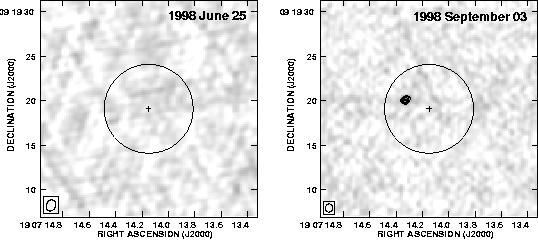Magnetar SGR 1900+14
Description
Astronomers using the VLA have found evidence for the most powerful magnetic field ever seen in the universe by observing an "afterglow" of subatomic particles ejected from a magnetar -- a neutron star with a magnetic field billions of times stronger than anything that can be created on Earth. Magnetars were proposed in 1992 as a theoretical explanation for objects that repeatedly emit bursts of gamma-rays called "soft gamma-ray repeaters," or SGRs. This emission comes from the interaction of subatomic particles with the magnetar's powerful magnetic field. These VLA images show the SGR called 1900+14 (also known as GRB 980829), with its short-lived radio emission turned off, left, and on, right. The circles indicate the area from within which the X-ray emission of SGR 1900+14 comes.
Creator
Legacy Astronomical Images
Rights
NRAO/AUI/NSF does not hold full copyright for this image. Contact the archivist for details.
Type
Legacy Astronomical Image
Object Name
GRB 980829
Investigators
Dale Frail, Shri Kulkarni, Josh Bloom
Telescope
Very Large Array (VLA)
Observation Date
1998-09-03
Type of Observation
continuum
Center of Image
RA 19:7:14.100, Dec: 9:19:19.000 (J2000)
Field of View
0.006944 x 0.006944 degrees
Series
Galactic Sources Series
Unit
Pulsars/Neutron Stars Unit
Citation
Legacy Astronomical Images, “Magnetar SGR 1900+14,” NRAO/AUI Archives, accessed April 1, 2025, https://www.nrao.edu/archives/items/show/33471.

